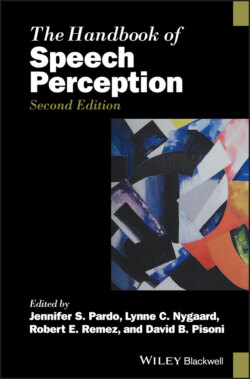Читать книгу The Handbook of Speech Perception - Группа авторов - Страница 46
Speech‐preferential areas
ОглавлениеThat areas of the brain exist that are necessary for the understanding of speech but not for general sound perception has been known since the nineteenth century, when the German neurologist Carl Wernicke associated the aphasia that bears his name with damage to the STG (Wernicke, 1874). Wernicke’s eponymous area was, incidentally, reinterpreted by later neurologists to refer only to the posterior third of the STG and adjacent parietal areas (Bogen & Bogen, 1976), although some disagreement about its precise boundaries continues until this day (Tremblay & Dick, 2016).
With the advent of fMRI at the end of the twentieth century, the posterior STG (pSTG) was confirmed to respond more strongly to vocal sounds than to nonvocal sounds (e.g. speech, laughter, or crying compared to the sounds of wind, galloping, or cars; Belin et al., 2000). Neuroimaging also revealed a second, anterior, area in the STG, which responds more to vocal than to nonvocal sounds (Belin et al., 2000). These voice‐preferential areas can be found in both hemispheres of the brain. Additional studies have shown that it is not just the voice but also intelligible speech that excites these regions, with speech processing being more specialized in the left hemisphere (Scott et al., 2000). Anatomically, the anterior and posterior STG receive white‐matter connections from the primary auditory cortex, and in turn feed two auditory‐processing streams, one antero‐ventral, which extends into the inferior frontal cortex, and the other postero‐dorsal, which curves into the inferior parietal lobule. The special function of these streams remains a matter of debate. For example, Rauschecker and Scott (2009) propose that the paths differ in processing what and where information in the auditory signal, where what refers to recognizing the cause of the sound (e.g. it’s a thunderclap) and where to locating the sound’s spatial location (e.g. to the west). Another, more linguistic, suggestion is that the ventral stream is broadly semantic, whereas the dorsal stream may be described as more phonetic in nature (Hickok & Poeppel, 2004). Whatever the functions, however, there appear to be two streams diverging around the anterior and posterior STG.
Over the years, these early STG results have been replicated many times using neuroimaging (Price, 2012). Each technique for observing activity of the human brain, whether it is noninvasive magnetoencephalography (MEG) or fMRI, or invasive surgical techniques such electrocorticography (ECoG; described in the next section), all have their limitations and shortcomings. It is therefore reassuring that the insights into the neuroanatomy of speech comprehension established by methods like MEG or fMRI, which can image the whole brain, are both confirmed and extended by studies using targeted surgical techniques like ECoG.
